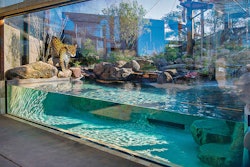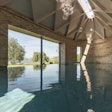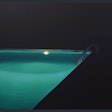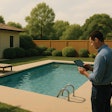When the first consumer drones debuted at the Consumer Electronics show in 2010, no one knew they would take off. But according to the Consumer Technology Association, more than 2.4 million personal drone units were sold in 2016, and sales are only expected to climb in the years to come. Business Insider, for example, projects sales will pass $12 billion in 2021.
After their introduction and wide acceptance from hobbyists, drone technology immediately began filtering into industries such as agriculture, media and law enforcement. It was only a matter of time before they made their way to the pool and spa industry for their ability to take aerial pictures of pools.
"When we're designing pools and backyards and home resorts, we're always drawing a plot plan or top view," says Scott Cohen, president of The Green Scene Landscaping & Pools (Chatsworth, Calif.). "We're showing the client the top view, but we never actually get to see that house from above like that. A drone, though, changes everything. Now we can see it from above. We can capture the photographs of a project or a video that we could never get without a drone."
Video courtesy of Custom Design Pools & Landscaping
Getting People Talking
Cohen isn't the only pool builder to use drones for his work. David Owens of Owens Pools (Junction City, Ore.) brings his drone to photograph clients' properties before, during and after construction. Using it in the early stages of the design process, he says, can provide valuable images to assist in CAD designs while also stoking the customers' excitement — an essential element of the homeowner/designer relationship.
"Really, it's just for fun for the customers. They like seeing their house from above and seeing overhead shots of us working. The drone flying over seems to get everyone pretty excited when I show up with it."
And, of course, drone footage yields captivating social media fodder.
"Right now, we have film students that work with us part-time and photograph projects for us on completion," Cohen says. "Then they create a video for the project before and after [construction]. We use that to post on our social media and our website."
RELATED: Capturing the Moment: The Power of Photography in the Pool Industry
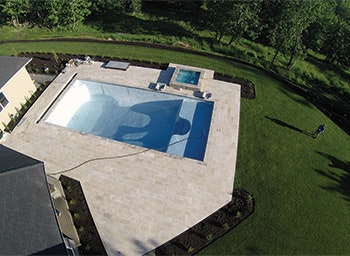 Aerial views such as these provide unique perspectives for marketing purposes and generate excitement among clients. And they're fun.
Aerial views such as these provide unique perspectives for marketing purposes and generate excitement among clients. And they're fun.
Damage Report
While drones have much to offer industry pros, they come with an inherent risk: crashes. Christopher Anderson, senior designer at Custom Design Pools (Houston, Texas), learned the hard way.
"I went out and bought a drone," he says. "It was exciting, it was fun, cost me $1,200 or $1,500. Of course, I ran it into a tree and replaced it. Then one of my friends was flying it and ran it into another tree."
With a dizzying number of drones on the market, all at a wide range of price points, it can be hard to decide which one to invest in. Owens suggests starting small.
"I tell people to go out and get a small, cheap drone to start out," he says. "I got a tiny one and played with that first. It was only $5. And then I flew it and thought maybe I can get a more expensive one."
When you're ready for a more expensive device, take a look at mid-level models that offer many of the benefits of more expensive units, without the price tag.
"If you're starting out in this, you do not need the most expensive drone," Cohen says. "People get all caught up in the definition and the quality of image and that sort of thing. Some of the lower-end drones that are under $500 will still do a fine job of taking pictures and video for you. We spent $2,000 to $3,000 on the drones we purchased. And the third one I bought was about $1,200, and that $1,200 one takes quality images and quality video just as well as a $3,000 one."
Again, investing less can be a smart move initially. Cohen lost his first two drones after they each took an unexpected dip in a swimming pool. "Yeah, they don't swim well," he says with a laugh.
Owens opted for a 3DR Solo, a relatively inexpensive drone that starts at about $230 and goes up from there, depending on accessories. (Part of the appeal of the 3DR, according to Owens, is that it is designed to accommodate GoPro cameras, which are sold separately.)
"The more expensive ones are easier to fly because they use satellites to keep it in position. [The 3DR], when it's going, has eight or nine satellites to keep it in the position all the time. You control it left or right, up and down, but it's always stable, even if the wind comes up. I think that's a key feature to have opposed to one without any of that, like my micro [drone]. I took the micro one outside and lost it because it got up in the wind and it was gone. Never seeing that one again."

Rules and Restrictions
Drones are regulated by the FAA, but the regulations vary depending on the reason for flying. For instance, a drone being used for work "must undergo a pre-flight check to ensure Unmanned Aircraft Systems is in condition for safe operation" (via FAA.gov). Regardless, drones over .55 pounds must be registered through FAA and cannot be over 55 pounds. Of course, these aren't the only restrictions to consider.
"When we're flying a drone, we want to be respectful of people's privacy," Cohen says. "It's not our intention to capture anything other than the pool and backyard that we're looking to work in. FAA regulations have mostly to do with flying them safely and at lower altitudes. We have no reason to be up that high. Most of the photography we do is within 40 feet of the ground."
"The 3DR has an app that locates the area and tells you if you need to call a local airport," Owens says. "It'll come up with a phone number. If you're going to fly in that area, you have to call the tower at the airport and tell them that you're going to fly. They have to approve it. If there's no number on the airport, you're usually pretty good."
However, it's always good to play it safe. Registering for a drone license costs only $10. The consequences for violating an FAA regulation range from fines to prison sentences.
"People do stupid things with drones," Owens says. "They float to the top of a skyscraper and post it on social media. FAA finds it, and the next thing you know, they're in jail or fined. You have to careful what you do and post."
RELATED: Hot Tub Sets Flight Record!
Keep it Professional
While drones are fun and yield awesome shots, they're not a shortcut to great photography. If you're a novice with a camera, you'll still be a novice with a drone camera, meaning it may be in your best interest to bring on a professional on board to assist.
"A lot of people think drones are used to fly up really high and take a shot looking down," Anderson says. "In reality, it's actually one of the worst ways to use a drone because it doesn't portray a beautiful image in most cases."
If you have a marketing budget, consider diverting some of those funds to hiring a professional videographer, who can help not only with shooting, but also editing and polishing it for extra wow factor.
"I will say that the fun wears off as a pool builder," Anderson says. "You buy a drone, you shoot three or four jobs and the fun wears off. It's new and cool and fun and you scratch your itch and all of the sudden you put it away in a case and it doesn't come out. In the end, you didn't do very much.
"Our job is to build and design swimming pools, that's what we're good at. We need to let other people do what they're good at. In the end, the reward will be much greater."
Video courtesy of Custom Design Pools & Landscaping
Don't Do This3 Tips For Better Drone PhotographyBrett Abbott, president of Pool Builder Marketing (Austin, Texas) is teaching a course on drone photography at the 2018 Pool and Spa Show in Atlantic City. Here, he shares a sneak peek of just a few tips to keep in mind for your next drone shoot:
For more drone advice, attend Abbot's class, "Taking Better Photos and Videos with a Drone," Wednesday, Jan. 24, at 10:15 a.m. at The Pool and Spa Show in Atlantic City. |




























